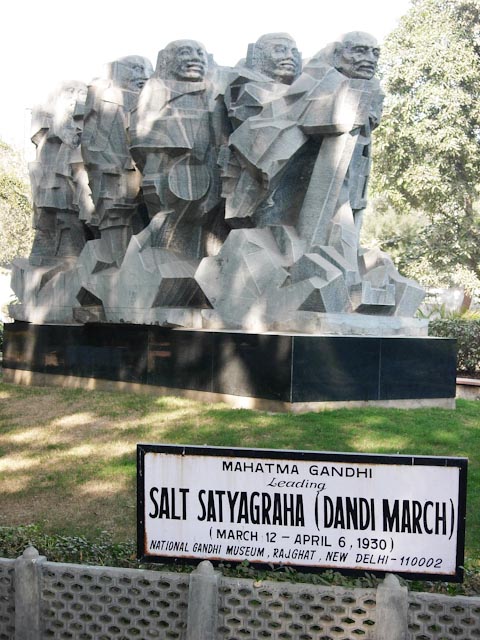The eastern end of Paharganj is flanked by the New Delhi train station. To get there, I pass under a spider web of electricity lines and cables, as well as past the usual suspects: the man who tries to sell me a toy helicopter every day, the man with the embroidery depicting a house and the man with the badminton racquets. I dodge the red splats of paan and worse, and try not to think of my own sooty congested lungs. Maybe if I live long enough they will turn into diamonds.
Eschewing all the offers of auto rickshaws and cyclists, I plan to walk east on Jawaharlal Nehru Marg until I find Raj Ghat and the Ghandi Memorial Museum. According to my map it looks to be about 7-8km one way. Indians (and probably the whities, too) think I’m nuts walking everywhere, especially when transport is so cheap, but I explain that slow progress makes for long observing (or to quote John Ruskin: ‘All travelling becomes dull in exact proportion to its rapidity’).
The characters and activities I’m treated to along the way are the reward. As long as you keep one eye on the ground, it’s all good, and I’m not just talking about stepping in something unpleasant. The number of open manholes I have seen is quite worrying. Peering in, you can only see the bottom if it is doubling as a rubbish receptacle.
Walking past an open piazza-like area, as with the Jama Masjid, you cannot put a pin between the pigeons. As I walk past I am confronted with the sound of 100 flapping fan belts. Oops, someone has disturbed them and the air is full of grey and flashes of steely green and lilac.
Raj Ghat is the site of the Mahatma’s cremation and this sacred spot is marked by a square of black marble constantly draped in strings of marigolds left by reverent devotees. Despite being outside, you must be barefoot to enter this special area. Families come to pay their respects and there is the usual crowd of supine loungers. The place is sunny and peaceful and is watched over by soaring kites keening and careering as they search for the next thermal. Nehru, Indira, Sanjay and Rajiv were also all cremated in the near vicinity.
Across the road is a memorial museum for Ghandiji himself. Like Nehru’s memorial, it is an in depth tribute to the life of a man considered to be a saint in his own lifetime. His early life as a solicitor in South Africa is covered with many photographs of him as a dapper young man in a suit in more hirsute days. His wife Kasturba features heavily in more than half of the pictures on show. Most of the accounts I have read of the Mahatma’s life have hardly mentioned her, so reading about her and the significant influence she wielded is very informative. Conversely, there was little to be gathered about Ghandi’s children except from the section about his death and cremation where his eldest son lit the pyre and later carried his father’s ashes for scattering in the rivers as instructed by his will.
No detritus from the Mahatma’s life is too insignificant to display. Right down to the stick he used as a toothpick and an ear cleaner (different ends I’m sure). Along the walls can be seen two bottom teeth that were extracted and his set of false teeth; his many wooden and leather sandals (made from non-slaughtered animals); his spinning wheels; and many letters, framed quotes and news clippings. Other glass cabinets in the centre of the room are full of shawls and bedding that were in his use. The major display however is the homespun he was wearing at the time of his assassination. The material is complete with blood spots and holes. Next to it are displayed one of the three bullets that ended his life, and the gun that fired it.

It is quite breathtaking to think of the immense impact this one man’s life had on such a large percentage of the world’s population (as well as beyond his own country) and the hope and dreams of independence he gave so many, even if he felt himself it ended in failure with the murder, rape and pillage that occurred at Partition in 1947. Given what is now happening on India’s back door step and beyond, it is hard to conceive of another leader in the future succeeding the way he did on the platform of love and non-violent protest.

Comments
Total Comments : ( ) You have to register to post a comment.
RECENT COMMENTS